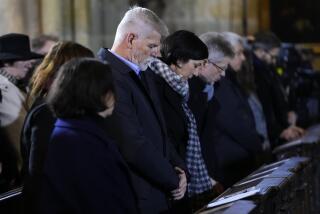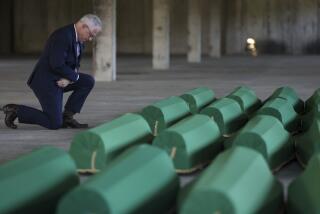Ratko Mladic is viewed as a world-class war criminal
- Share via
Shortly before the slaughter, Gen. Ratko Mladic patted the boys on their heads and offered them candy. He told the adults being herded in the city of Srebrenica that everything would be all right.
Within days, Mladic’s troops, said to be acting on his orders, had killed about 8,000 of Srebrenica’s men and boys, lining them up, opening fire and dumping their bodies in mass graves; many of the women were raped.
It was this chilling cynicism that marked Mladic, in the words of a former NATO officer, a world-class war criminal.
Photos: Ratko Mladic and the Bosnian war
The 1995 Srebrenica massacre, the worst human rights atrocity in Europe since World War II, was one of many horrors attributed to Mladic in an ugly war that bloodied that southern corner of the continent for half a decade.
Mladic is also accused of having masterminded the 3 1/2-year siege of Sarajevo, the Bosnian capital and a lovely mountain-ringed town that had hosted the Olympic Games and had been home to three peacefully coexisting and often intermingling faiths. Mladic’s Bosnian Serb forces surrounded the city, starved and shelled it, and killed thousands of people, mostly civilians.
Both the Sarajevo siege and the Srebrenica massacre constitute the basis for an indictment on two counts of genocide handed down by the United Nations war crimes tribunal shortly after the fighting ended in late 1995.
The court at The Hague indicted Mladic, as commander of the Bosnian Serb army, and Radovan Karadzic, who served as the Bosnian Serbs’ president. Both eluded arrest for more than a decade. Karadzic was finally taken into custody in 2008, Mladic on Thursday.
“Scenes from hell, written on the darkest pages of human history,” is how the tribunal judge described what Mladic wrought.
The war in Bosnia-Herzegovina was part of what would result in the disintegration of Yugoslavia, which only a few years earlier was a relatively moderate communist nation of six republics with power centralized in the Serbian capital of Belgrade.
With the decline of Yugoslav communism in the late 1980s, the republics of Slovenia, Croatia and finally Bosnia began to attempt to break away from Belgrade’s control. And though there was serious fighting in Croatia, the brunt of it ravaged Bosnia, where the term “ethnic cleansing” was added to the lexicon as entire villages were wiped out.
All sides committed atrocities, but the mostly Roman Catholic Croats and the mostly Eastern Orthodox Serbs, such as Mladic, stand accused of the majority of crimes committed in some cases against each other but primarily against Bosnian Muslims. About 100,000 people were killed and more than 2 million displaced.
“For me, Mladic was the military symbol of the total ruin” of Yugoslavia, said Laura Silber, coauthor of one of the definitive accounts of the conflict, “The Death of Yugoslavia.”
“He knew how to charm, to manipulate, to scare … and to knowingly send 8,000 men and boys to their death,” said Silber, who first met Mladic in 1993 when she was a Belgrade-based journalist covering the region. She described his steely ability to dominate his surroundings, his men and even, at times, the international mediators who had to deal with him.
“He barked in a way that would stop you in your tracks,” she added in a telephone interview from New York.
To his supporters, and there were many during the war and afterward, Mladic was defending his nation; he was a military hero who fought to destroy an enemy before it did so to his people. His followers also admired his stubborn ability to defy Western Europe and the U.S., which many Serbs resent for what they see as decades of imperialistic interference.
To his many victims, and to a legion of international human rights and aid workers, Mladic embodied evil.
He is thick-necked and square-jawed, and his narrow blue eyes seemed to stare right through people. Initially, at least, his resolve and forcefulness commanded respect from some of those who would eventually hunt him, as well as the undying loyalty of many of his men, a loyalty that undoubtedly helped protect him after the war.
It was the Srebrenica massacre that in some ways precipitated the end of the war because its savagery finally propelled the U.S. and its North Atlantic Treaty Organization partners to intervene. The wretched enclave had been declared a safe haven by the U.N. and tens of thousands of Bosnians, most of them Muslim, sought refuge there to escape Serbian attack. Mladic, even as he met with U.N. officials to negotiate the “surrender” of the enclave, moved his troops into Srebrenica in July 1995. A few hundred Dutch U.N. peacekeepers guarding Srebrenica were quickly overrun and outgunned. They allowed Mladic’s troops to remove the Bosnians after he promised their safe passage.
Instead, males were separated from females. Most of the women and girls were placed on buses and sent to Bosnian-controlled territory, while the men and boys were forcibly marched into the rough countryside. About 8,000 were systematically executed and dumped in mass graves that eventually dotted the landscape. It would be years before bodies were recovered and identified in substantial numbers.
Mladic was the “face” of the Srebrenica atrocity, said Peggy Hicks, a veteran human rights advocate who formed part of the first U.N. team to interview Srebrenica survivors in 1995.
“Until the architect of Srebrenica was in The Hague,” she said, “the Srebrenica tragedy would never have been fully addressed.”
Photos: Ratko Mladic and the Bosnian war
Mexico City bureau chief Wilkinson was previously based in Vienna and Rome and covered the Balkans for The Times.
More to Read
Sign up for Essential California
The most important California stories and recommendations in your inbox every morning.
You may occasionally receive promotional content from the Los Angeles Times.














